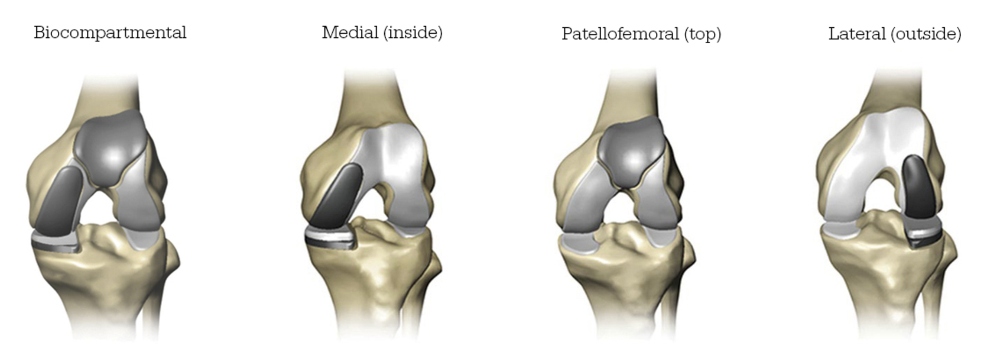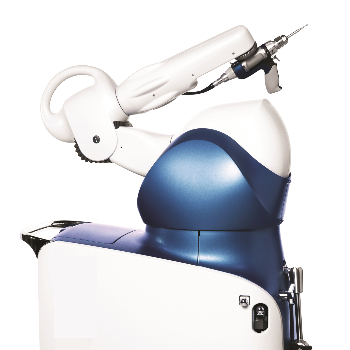ROBOTIC PARTIAL KNEE REPLACEMENT PERTH
Robot-Assisted Partial Knee Replacement Surgery
A patient’s guide:
Dr Arash Taheri
MBBS (Hons), BMedSci (Hons), FRACS (Orth)
Orthopaedic Surgeon
Robotic Surgery Specialist.
Over 2000 Robotic Surgeries.
Robot-Assisted Partial Knee Replacement Surgery
Partial Knee Replacement Surgery
What is Partial Knee Replacement Surgery – During partial knee replacement surgery only a portion of the knee is replaced with artificial components called a prothesis.
The prothesis may be made from stainless steel, titanium, ceramics, polyethylenes and cements made of acrylic polymer.
This procedure is an alternative to total knee replacement for patients whose disease or damage is limited to just one area of the knee.
Because a partial knee replacement is done through a smaller incision, patients usually spend less time in the hospital and return to normal activities sooner than total knee replacement patients.
Dr Taheri will discuss with you the potential benefits and risks of partial knee replacement surgery.

What Happens During Partial Knee Replacement Surgery
What is Robot-Assisted Partial Knee Replacement Surgery – In robotic partial knee replacement surgery, only the damaged portions of the knee are replaced. The knee can be divided in to three areas, the medial (inside), lateral (outside) and patellofemoral (knee cap) compartments. The robotic arm assists in resurfacing the damaged portion of the knee, but prevents damage to the healthy areas.
Prior to surgery, pre-operative X-rays and CT scans are obtained to generate a 3D model of your knee using MAKO Robot-Assisted Technology. This aids in ‘pre-planning’ your partial knee replacement.
During surgery, a computer is used to match the pre-operative plan to your knee, and a robotic arm is used to assist the Dr Taheri in placing the prosthesis in the optimal position by guiding the robotic arm to precisely remove bone and cartilage to assist in the partial knee replacement surgical process.

Advantages of Robot-Assisted Partial Knee Replacement Surgery
There are a number of factors that affect successful patient outcomes after Partial Knee Replacement surgery.
The two major factors Dr Taheri can influence include:
- Choice of implant used in the surgery and;
- The precision with which the implant is placed – Including bone cuts, alignment and function.
Dr Taheri uses the Stryker Triathlon Total/Partial Knee Replacement System for his Total/Partial Knee Replacement surgeries (it is the most commonly used and one of the best performing Partial Knee Replacement Systems in Australia and the World).
Accurate Bone cuts determine the alignment and function of the knee implants and poor alignment can result in early implant failure.

The MAKO Robotic-Arm allows:
- More precise bone cut
- More precise implant placement
- Assists in balancing the soft tissues around the knee
This approach allows smoother joint movement throughout the full range of motion preventing overloading of the other parts of the knee. MAKO Robot-Assisted technology research data shows it has a lower revision rate than the same components implanted using any other technique.
Evidence also exists to show patients undergoing MAKO Robot-Assisted Partial Knee Replacement commonly have:
- Less post-operative pain and stiffness
- Reduced soft tissue surgical wounds and scarring
- Decreased pain medication requirements
- Faster rehabilitation times
- Increased range of movement
- A shorter hospital stay
- Higher patient satisfaction scores.
Over 95 percent of Dr Taheri’s partial knee replacement surgeries are done as an overnight hospital stay. Dr Taheri’s surgical approach and Enhanced Recovery After Surgery (ERAS) program has lowered the length of hospital stay for patients dramatically.
Pain Management
After Robot-Assisted Partial Knee Replacement Surgery
In recent years Anaesthetists who specialise in pain management and control have substantially improved pain management in relation to Partial Knee Replacement surgeries.
There have been major advancements in multi-modal pain management techniques that substantially reduce the pain discomfort from surgery and post-operative recovery. When combined with the post-operative data of MAKO Robot-Assisted Partial Knee Replacement technology patients may experience less pain and require less post-operative pain medication as a result of less soft tissue trauma – which translates to less pain.
Patients may still experience some mild discomfort. Most patients are generally encouraged to stand and walk within hours of surgery. Please report your pain levels and discomfort to the nursing staff.
Rehabilitation
Robotic Partial Knee Replacement Perth
Rehabilitation is a major element in determining a successful outcome of Partial Knee Replacement Surgery. Rehabilitation is driven by physiotherapist professionals and the hard work and dedication of the patient to get back to normal activities as fast as possible. The rehabilitation process starts the day after the surgery and is an ongoing process for at least 6 months.
The rehabilitation program may help with:
- Reducing post-operative pain and stiffness
- Decreasing pain medication needs
- Reducing soft tissue healing times
- Shortening your hospital stay
- Increasing the range of knee movement
- Getting back to everyday activities faster
- Higher levels of patient satisfaction.
Your knee rehabilitation program will be discussed in depth with Dr Taheri and your physiotherapist and designed to meet your specific needs and concerns.
Risks and Complications
Robotic Partial Knee Replacement Perth
As with any major surgery, there are potential risks involved. The decision to proceed with the surgery is made because the advantages of surgery outweigh the potential disadvantages. It is important that you are informed of these risks before the surgery takes place.
Complications can be medical (general) or local complications specific to the Knee. Medical complications include those of the anaesthetic and your general well being. Almost any medical condition can occur so this list is not complete. Complications may include:
Allergic reactions to medications – There may be a risk of adverse reactions in relation to the medications used during and post-surgery recovery.
Blood loss requiring transfusion – There is a low risk of disease transmission through blood transfusions.
Infection – Infection can occur with any operation. In the knee this can be superficial or deep. Infection rates are approximately 1%. If it occurs, it can be treated with antibiotics but may require further surgery.
Blood Clots – These can form in the calf muscles and can travel to the lung (Pulmonary embolism). These can occasionally be serious and even life threatening. If you get calf pain or shortness of breath at any stage, you should notify your nursing staff and surgeon immediately.
Knee stiffness – Ideally, your knee should bend beyond 115 degrees but on occasion, may not bend as well as expected. Sometimes further manipulations and treatment are required
Wear and tear – Over time, the plastic liner eventually wears out. This may take 10 to 15 years and may need to be replaced.
Bone breaks – Fractures or breaks can occur during surgery or afterwards if you fall. To repair these, you may require surgery.
Wound irritation – The operation will always cut some skin nerves, so you will inevitably have some numbness around the wound. This does not affect the function of your knee joint. You can also get some aching around the scar. Vitamin E cream and massaging can help reduce this. Occasionally, you can get reactions to the sutures or a wound breakdown that may require antibiotics or rarely, further surgery.
Cosmetic appearance – The knee may look different than it was because it is put into the correct alignment to allow proper function.
Leg length inequality – Your leg will be restored to its original length as the deformity caused by wearing of the knee has been corrected.
Ligament injuries – There are a number of ligaments surrounding the knee. These ligaments can be torn during surgery or break or stretch out any time afterwards. Surgery may be required to correct this problem. This problem is minimised with Robotic Assistance.
Damage to nerves and blood vessels – These may be damaged at the time of surgery. If recognised they are repaired but a second operation may be required. Nerve damage can cause a loss of feeling or movement below the knee and can be permanent.
Nerve damage – These may stem from nerve blocks such as infection or nerve damage.
Other complications – Stroke, heart attacks, kidney failure, pneumonia and bladder infections.
Serious medical problems can lead to ongoing health concerns, prolonged hospitalisation or rarely death.


